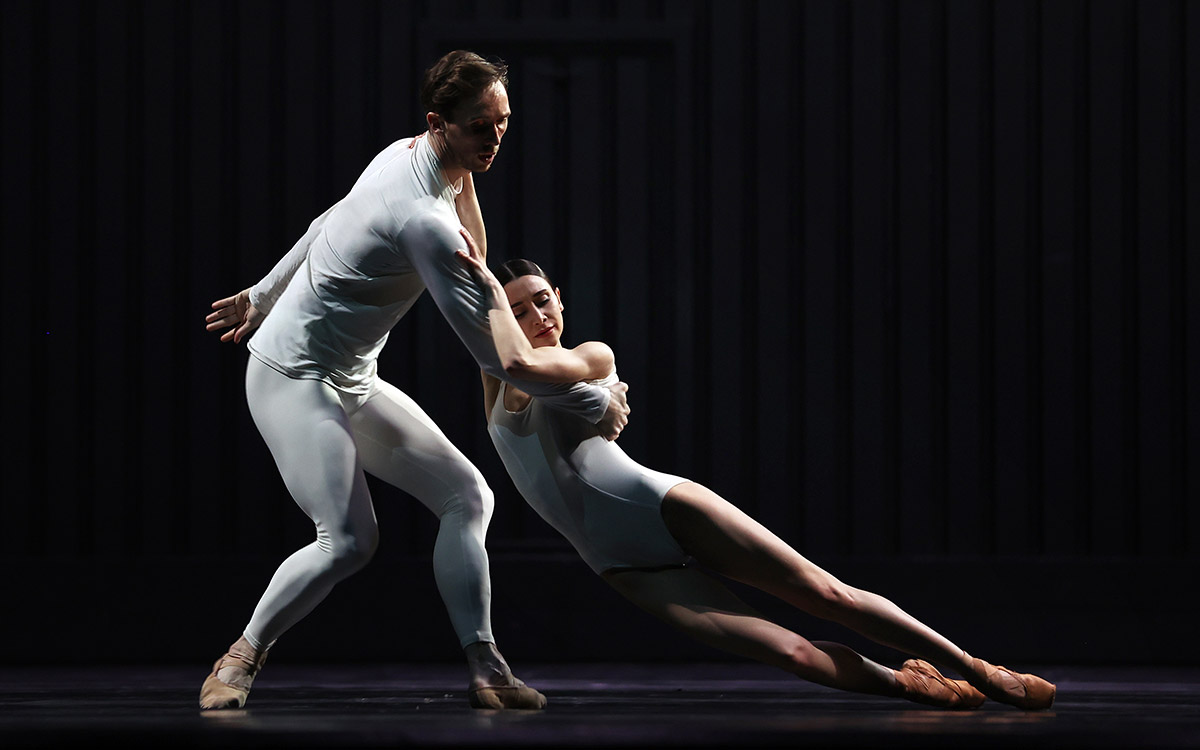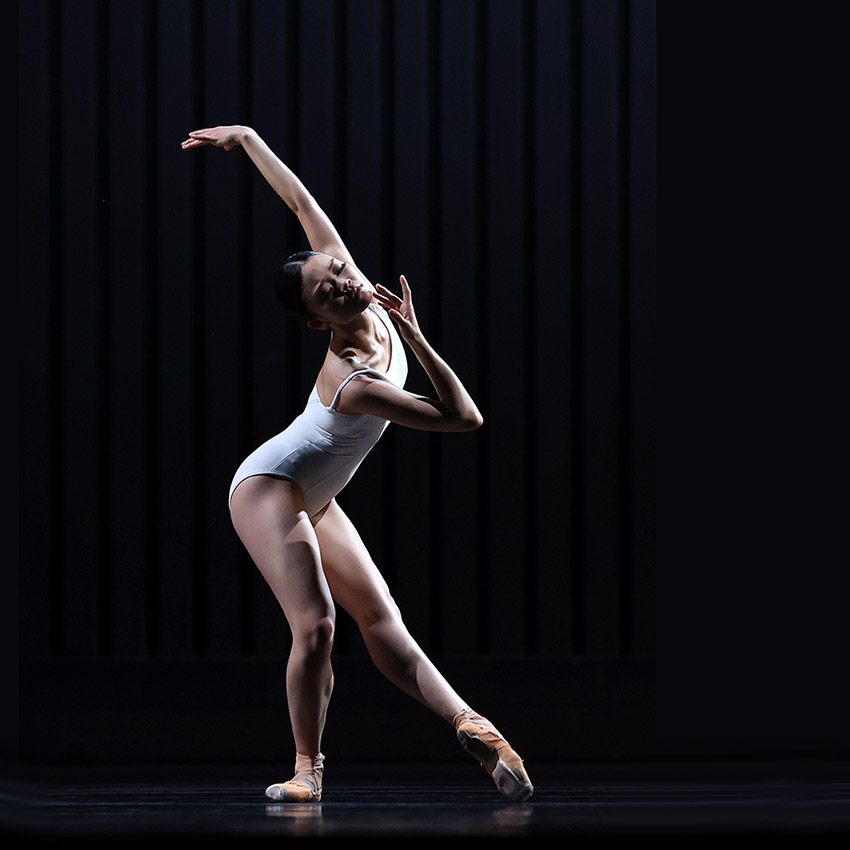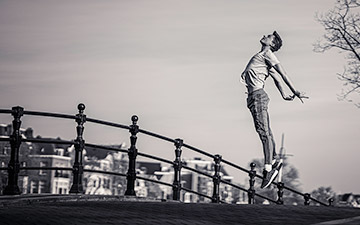
© Hans Gerritsen. (Click image for larger version)
Dutch National Ballet
METAMORPHOSIS
★★★★★
Online premiere 29 April 2021
Available to stream until 29 October 2021.
www.operaballet.nl
For International Dance Day, Dutch National Ballet launched the film of the world premiere of Associate Artist David Dawson’s full version of METAMORPHOSIS, to music by Philip Glass of the same name, Metamorphosis I-V (1988). Available to watch until the end of October, it is worth investing 37 minutes to slip into its addictively mesmeric world. Created entirely on Zoom between Dawson’s home in Berlin and DNB’s studios in Amsterdam, this is an innovation that proves a pandemic cannot halt a creative artist or artists at work. Indeed, Dawson has proved time after time, that hurdles merely feed his determination to produce something original, indelibly marked with his own choreographic voice.

© Hans Gerritsen. (Click image for larger version)
Dawson states that the premise for his creation is about, “hope and humanity, about finding light in the darkness”. And he succeeds mostly because of the sheer beauty of the dancing, the shapes and patterns the dancers make, the freedom of the torso within all port de bras and his almost imperceptible and uncanny ability to integrate pure classical dance with 21st century ingenuity. A simple 90º arabesque, melts mellifluously into a sweeping, diving movement which in turn takes flight into a galloping run. A perfect fifth position, caught in a momentary, motionless state, dissolves or explodes into expansive, voluptuous arcs and curves. It is an education in how to utilise the classical vocabulary and take it to extremes, stretching the imagination and the body to discover how broad the movement can be without losing the framework or line. More importantly perhaps, it’s taking that basic vocabulary, then liberating and enhancing it. A jeté morphs into a pirouette with the head thrown back, defying the norms of balance and orientation – a line of dancers executing steps in canon has a rippling, waterfall effect that is a deeply satisfying visual feast. Dawson allows his dancers to look like masters of control, but within the context of complete freedom, and all this is captured as a response to Glass’s music. Indeed, if the piano music, beautifully played by Olga Khoziainova, is a little repetitive – it is not reflected in the choreography, nor does it matter that it flaunts recurring themes.
The first movement, a duet for Anna Ol and James Stout, has already been seen in a mixed programme for DNB’s Christmas Gala. Both are wonderful exponents of what can best be described as Dawson’s challenging invention. There is nowhere to hide in simple white leotards or unitards and yet they come as close to perfection as one could wish. Faultless, flat-footed spins, dead lifts that Stout makes look easy, an emotional connection that is not defined by narrative, yet is tangible and moving – it’s riveting. As if in some kind of miraculous symbiotic union, this is blissful pairing.
The second part sees 10 dancers, four men and six women, unfold and disperse in a never ending mass of lyrical movements, like a flock of migrating birds. They are inextricably linked as they conform to the movements but all effectively fly solo – lost in their own individual backstory.

© Hans Gerritsen. (Click image for larger version)
Four men take on the third movement. Young Gyu Choi, Edo Wijnen, Joseph Massarelli and Sem Sjouke are surreally glorious as they leap into the air, aloft like gazelles finding their jumping legs and feet, swallowing up the stage with ferocious zeal. Graceful in the extreme – this section felt like it ended all too soon.
Three couples inhabit the fourth movement, each partnership establishing greater trust as it progresses and with this, a deeper sense of hope. Riho Sakamoto carries the fifth and final part in majestic style. A wonderfully sensuous dancer, musical, with speedy turns and excellent control, the magic moment comes when the light falls on her face, a whisper of a smile emerges and then breaks. She walks backwards with purpose as the ballet concludes. Bert Dalhuijsen’s lighting design is superlative, as is Altin Kaftira’s camera direction.

© Hans Gerritsen. (Click image for larger version)
The litmus test for a successful ballet is whether, at its close, one wishes to see it again. As a vehicle for some really world class dancing, I am binge watching (if Netflix can coerce an audience, why not the dance world?), on my fifth viewing already and revelling in it. Covid restrictions permitting, I believe that this would be a sensational addition to the repertoire in a live theatre/audience setting.

















When ? When ? When? Will critics stop glistening in self serving grandiose , do their research and give an informed analysis that doesn’t exude drooling praise
Dancing was good, as it should be for a world class company like DNB, as it was the physical performance by the dancers but choreography was repetitive, vocabulary limited, phrasing and patterns hardly inventive or groundbreaking with an overuse of the timing in canon that I have only seen used repeatedly in student shows and displays of synchronised swimming ( with more imagination ). It virtually conforms every stereotype down to not a single lady leaving the floor except when aided , albeit for one brief sissonne on the last solo. A total disservice to the interpretation of the score and of the subject matter .Yes , better continue binging on Netflix , no offence .